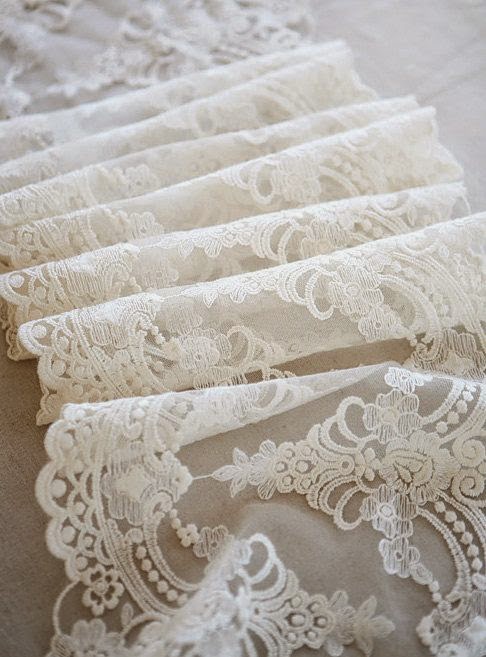Random Tuesday #7
~ Vintage Lace ~
Of many Arts, one surpasses all. For the maiden seated at her work flashes the smooth balls and thousand threads into the circle, ... and from this, her amusement, makes as much profit as a man earns by the sweat of his brow, and no maiden ever complains, at even, of the length of the day. The issue is a fine web, which feeds the pride of the whole globe; which surrounds with its fine border cloaks and tuckers, and shows grandly round the throats and hands of Kings. Jacob van Eyck, 1651
I love lace and love wearing it on my clothes. Its feminine and beautiful and for that reason alone, women have been wearing it through the centuries. Essentially, there exist two kinds of lace: needlepoint lace and bobbin lace.
Needlepoint lace is made with a single-thread technique using embroidery stitches while bobbin lace, developed after needlepoint lace, was made with a variety of multiple-thread weaving techniques. The first known lacemaking pattern books came from 16th c. Italy. Lacemaking techniques quickly spread to Spain and from there north to the Spanish Netherlands, France, Germany and England. "In the quintessential Elizabethan era, lace ruffs were worn in various incarnations by all but the lowest classes. Yards of lace were required for a single modest ruff, making elaborate ones were extremely costly. Ruffs were not the only lace items in demand at this time. Lace was used to trim anything from altar cloths to ecclesiastical vestments to tooth cloths and pillow beres (pillow cases).
Bobbin lace, the kind which is represented in Vermeer’s famous painting "The lacemaker" (below), had been developed to provide the borders of garment, caps, pillows, tablecloth etc. with tough but likewise decorative elements.
Demand for lace was so high and widespread in the 1500s that many women became lacemakers. Lace schools for village girls were founded by noblewomen, their patronage being paid for in lace, no doubt. Children of both genders were enrolled at about age five or so, with boys usually leaving as they grew strong enough for harder labor. Not that the life of a lacemaking student was easy. Even children worked from dawn till dusk, often in crowded, unventilated rooms without even the most primitive of sanitary facilities.
Lace can be made using crochet, tatting, knitted lace and a variety of other decorative, openwork textiles.
 |
| The Lacemaker by Jan Vermeer |
Do you remember the the Duchess of Cambridges wedding dress and its beautiful lace. Here is some interesting facts about that lace:
- It took at least 23 artisans to produce ‘Kate’s lace’.
- The lace took over 5 weeks to make.
- After each loom’s 5000 shuttles are painstakingly threaded the machine is only capable of producing 60 metres of lace per day.
- The design of the lace is 54 years old.
- The looms used to create the lace were invented in 1809 and the modern day loom used uses the same technology with bobbins and shuttle.
- The lace design was French but the looms are English.
Source:
******


I love lace. I have a lace throw and a scarf that I wear often. Lace curtains hang in my bedroom. Kate's wedding dress was stunning!
ReplyDeleteWhen I am sewing, I always have a look to see if I can add a little lace!!!
DeleteHer dress wasn't just beautiful, it was an example of modesty too :)
DeleteI LOVE lace. It's just so feminine and beautiful!
ReplyDeleteCompletely agree :) Your wedding dress had some beautiful lace on it.
DeleteJo. This was a very informative post! I also love, lace and think it is an art that is so pretty! My Mother made lace doilies! I still have a few of them!
ReplyDeleteHugs, Roxy
I have a few older doilies which I like to use, one is on my dinning table.
Delete